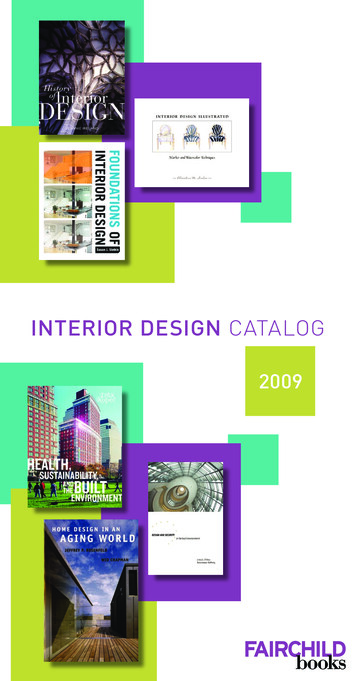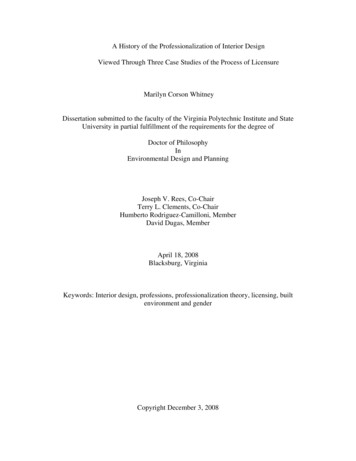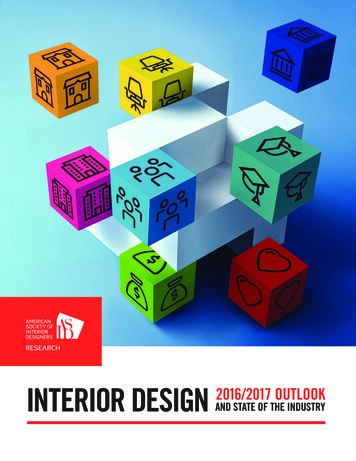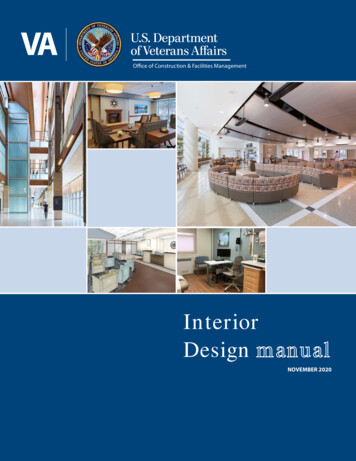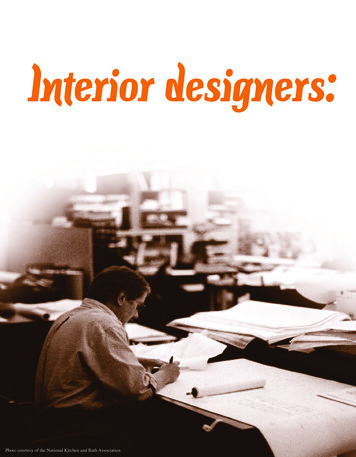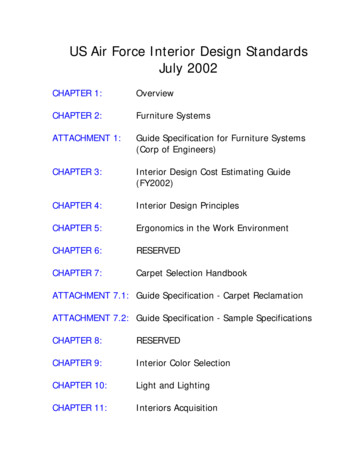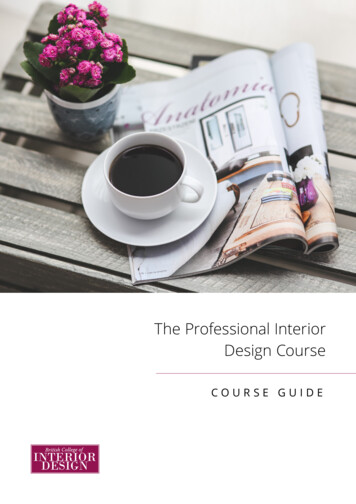
Transcription
The Professional InteriorDesign CourseCOURSE GUIDE1
Indulge yourpassion or starta new careerin a dynamicand challengingindustry.Contents3Discover interior design5About the course6What you can achieve7Content from the pulse of the industr y8Hand in hand with your tutor9What you will learn9What you will receive10Do you have what it takes?12Course outline14Upon completion1510 Reasons why the grass is greeneras an interior designer16Our guarantees17Course fees18Star t your next adventure19About the British College ofInterior Design
Discover interior designThe Professional Interior Design Course has been designed to provide you with theprofessional skills required to succeed as an interior designer. The course offers you aunique opportunity to develop a full or part time career as a professional interior designeror to use your skills as a profitable sideline.At the outset, it is important to understand that this course is not simply about the theoryof interior design. It’s also about practical work in interior design, meeting client’s needs,marketing your services and being paid for your design skills.In essence, this course is about interior design for profit. Each week, thousands of potentialclients whether for home or business, require the skills offered by the interior designer.These are for new homes, offices and commercial interiors - for renovations, makeoversand pre-sale inspections. These needs are fulfilled by the professional interior designer.What makes a successful interior designer? Stated simply, they know how to go about it.In constructing this course, the British College of Interior Design has created one ofthe few opportunities for those not currently involved in the industry to become paidprofessionals, with a range of interior design work opportunities at their fingertips.When you complete this course you will have the knowledge and skills to start your owninterior design consultancy, to work as a freelance interior designer, or to seek work in themany businesses and industries associated with interior design.You’ll find the interior designer at work in thousands of homes and businesses. They arechoosing functional lighting, furniture, fabrics and window treatments. They are addingwall and floor coverings and choosing colour and decorative options. They are meetingwith clients, contractors and suppliers.Private clients, businesses, builders, architects and real estate agents have an ongoingneed for design skills. There are literally dozens of income-producing opportunities forthe knowledgeable interior designer.In short, The Professional Interior Design Course takes you through every aspect of theprofession - from developing design concepts and turning them into reality, through tothe business of selling your design skills and services. You provide the interest in interiordesign and the willingness to learn, while the British College of Interior Design providesyou with the practical knowledge and skills. You will soon be ready to take your first stepsinto the exciting and challenging world of interior design.Enjoy the journey!3
At the end of your course,you will have acquired alevel of skill where you cantake on any assignmentyou choose.4
During your course you will be instructedin all aspects of interior design by ateam of Britain’s, and the world’s leadinginterior designers, design writers andmanufacturers of design materials.About the courseThe Professional Interior Design Course is provided by distance learning. The coursecomprises 12 in-depth tutorials delivered to you online, over 12 or 24 weeks. However,your course is self-paced and you may take as long as one year to complete yourassignments and graduate from the course. Having said this, remember deadlines arealways important to the professional interior designer.During your course you will be instructed in all aspects of interior design by a team ofBritain’s, and the world’s leading interior designers, design writers and manufacturers ofdesign materials.As you progress through the course you will be learning about the actual marketplace foryour design skills, how to go about creating functional and appealing design concepts,selling your services and tricks of the trade to ensure your success.From your first assignment, you are working with your tutor towards commencing yourown freelance design consultancy and being paid for your efforts.This course has been specifically designed with our student’s work and family commitmentsin mind. Our assignments have no due dates, so you can simply hand in your work whenyou are ready. If you find yourself stuck on an assignment, we have a large collection ofassignment examples and resources to use as a guide for your own work.If you are having difficulty in a certain area, or if other commitments are intruding uponyour time, the facility also exists to hold further tutorials until you are ready to continue.Simply email the College and request a new delivery schedule.One of the most important aspects of the course is its British focus. Although the principlesof interior design are similar the world over, this course concerns itself specifically withthe British aspects of design. It’s this direction and emphasis that will greatly help toensure your success.5
What you can achieveA full or part-time career in interior design offers one of the few remaining opportunitiesfor individual freedom, self-expression and financial gain. It’s also a lot of fun and can leadto varying degrees of fame and fortune.This course gives you the opportunity of being your own boss and working from home.With a home office and low overheads you can start as a self-employed interior designerand build your business and reputation project by project. You may choose to find workin a larger design company, where you can develop your professional contacts, gain agreater sense of self-confidence and build a following of satisfied clients.Work opportunities for trained interior designers are everywhere. You can operateyour own business, work freelance or seek assignments in design or architecturalconsultancies, in department and furniture stores, hotel and restaurant chains, antiquedealers, furniture and textile manufacturers, as well as in display and merchandising. Ifyou prefer a sales career, selling or working with furniture, carpets, wallpapers or anyrelated field, your training will prove of great benefit.Using the knowledge and skills you’ll acquire through this course, you may also chooseto turn your own home into a showcase of your talent, with your surrounds being alive portfolio of your design ability. It would also assist anyone looking to do their ownhome renovation. With experience, your commissions can eventually vary from designingresidential interiors, to interiors of large public buildings like galleries, exhibitions and tradeshows, or commercial interiors like offices, retail spaces and holiday rental apartments,or hospitality interiors for cafes, restaurants and bars. Remember, the interior designer iseven needed to design film and television sets. Perhaps this might be you.Interior design is one of the few professions that does not discriminate in any way. Youcan be any age, sex, race or religion and become a successful interior designer. You canwork from home or office. To a large degree you can choose your own hours and thenature of the work you accept. This craft does not demand a university degree or otheracademic qualifications. Once you know what the industry requires, you have a highlymarketable skill.This course will show you how to navigate the interior design industry. At the end of thiscourse, you will have the necessary training and skills to successfully handle virtually anyassignment. You will have an insider’s knowledge of what the market requires and how togo about providing it.By definition you become a professional interior designer with your first paid assignment.You’ll find that interior design is an adventure, limited only by your own imagination andflair - qualities which will be further developed throughout this course.Be prepared for one of the most exciting and rewarding experiences of your life!6
Content from the pulseof the industryThe British College of Interior Design has recruited many respected interior designers anddesign writers to assist you throughout your course. Their skills and experience, coveringall industry areas, will provide you with an intimate knowledge of how to take on any brief.SIMON SAVAGE: SENIOR TUTORSimon is an interior and building Designer, whoholds a master’s degree in interior design. Trainedin Amsterdam, his designs and projects regularlyfeature in interior design magazines. Simon is alsoSenior Tutor for this course.BRETT TUDOR: CONTRIBUTORBrett is currently working as a freelance journalistspecialising in home interiors and garden design. Aself-confessed interior design addict fascinated bythe nuances of fashion in the home, he has a keeninterest in being hands-on and taking charge of theprocess of decorating from start to finish.MARK POLLACK: CONTRIBUTORMark Pollack of Pollack Associates in the US is oneof the world’s leading and most innovative textiledesigners. Here he explains the thinking behind hisdesigns and makes some pertinent points on thestate of design in general.CLARE HOPPING: CONTRIBUTORClare is a freelance writer for a range of magazinesincluding The Native Lifestyle Magazine, Host CityArchitecture magazine and Health and Safety at WorkMagazine. She is also a regular contributor for anumber of other interior design industry magazines.SHARON DAVIS: CONTRIBUTORSharon is an experience design writer andregular contributor to many high profile interiordesign and property magazines and websites.Publications Sharon writes for include Period Ideas;25 Beautiful Homes Magazine; Kitchens, Bedrooms &Bathrooms Magazine; Real Homes; A Place in the SunMagazine; Portugal Magazine; and Homebuilding &Renovating Magazine.EMILY BROOKS: CONTRIBUTOREmily is an experienced design writer and regularcontributor to BBC Homes & Antiques; Elle Decoration;Build It and World Health Design. Emily is also theauthor of Spectacular Homes of London, an interiordesign book published by Panache Publishing.BRIGETTA BUNDY: CONTRIBUTORBrigitta Bundy studied interior design in Vienna,Austria, then worked as a model for someyears before having a family and specialising inkitchen design.JO WALSH: CONTRIBUTORJo juggles freelance work with the demands of ayoung family. Having worked extensively for bothlifestyle and business publications, she knows how tocreate the perfect balance between the artistic andthe practical.7
Your tutor is ahighly qualifiedprofessional currentlyworking and familiarwith current trends.Hand in hand with your tutorWhen you first enrol in The Professional Interior Design Course, you are asked to completeour Tutor Information questions. These provide the College and your tutor with valuableinformation about what you wish to accomplish and the areas of interior design that mostinterest you.With this information you are assigned a personal tutor. Your personal tutor is chosento best assist you, based on what you hope to achieve from the course and the areasof interior design in which you wish to operate. Your tutor is a highly qualified industryprofessional currently working and familiar with current trends.Please regard your relationship with your tutor as a partnership. It’s your tutor’s role toensure your progression throughout, and to work with you until you complete the course.Your tutor will work with you as closely as possible to help you accomplish these goals byproviding in-depth feedback to your assignment submissions.This partnership with an industry professional who has been specially chosen to helpyour career objectives is one of the great benefits of this course.8
What you will learnThe course will teach you all the most important aspects of interior design.This course presents fundamental design concepts and explores all aspects of the interior - human factors,building structure and technology, environmental and other building systems, contextual issues, designtheories and methods, and communication.You’ll also discover the many aspects of human occupation of interior space and how lifestyles and socialpreferences affect interior design. You’ll learn about design theory and history, design communications,design research and the science of interior space. You’ll also learn how to analyse clients’ needs, developappropriate design concepts and manage the finishing of interior spaces.What you will receiveYou will receive: 12 tutorials dealing with professional interior design.Details of the eight college assignments, to be completed before graduating from the course.Contributions from leading interior designers, design writers and design product manufacturers.Individual correction and advice in respect to your ideas and assignments.In-depth feedback from your tutor for each course assignment.Information on industry trade exhibitions, how to keep up with interior design trends, and sustainabledesign.And: Suggested standard contracts and fee structures.Working papers and templates.Plus: General information on computer-assisted design and how it can aid your business.Analysing and evaluating space and preparing floor plans.How to go about setting up your professional practice.9
Every interior designer wasonce a complete beginner.Do you have what it takes?So what’s required of you to become a professional interior designer capable of handlingany and all assignments? The requirements are simple and straightforward:1. An interest in interior design2. A little flair3. The willingness to learnIf you have these qualities, the British College of Interior Design will provide you with theknowledge and skills to ensure your success.There are no rules to being a successful interior designer. You need no specialisedqualification other than the desire to succeed.A successful interior design consultant does not have to be gifted. Every interior designerwas once a complete beginner. Success is very much a matter of knowing how to goabout it.More and more private individuals, business houses, builders, architects and real estateagents are relying on freelance interior designers. And, with thousands of homes, homeunits, offices and retail premises to be designed or renovated, why not?However, as you’ll discover, the need for your design skills doesn’t end here. There is arange of other lucrative freelance and full time work to be obtained including projectmanagement, styling properties for pre-sale inspection, colour consultancy, functionaland appealing bathroom and kitchen design, exhibition design, retail showroom workand more.Remember, even a simple office at home has desking, storage and technologyrequirements. And, somebody gets paid for designing them.As you’ll also discover, interior design is a business that goes far beyond design concepts.By the time you complete this course, you will have an intimate knowledge of all aspectsof interior design - from developing your ideas through to the important business side ofmarketing your professional skills and being paid for your efforts.What’s more, you’ll be learning about the industry from the inside, receiving hundreds oftips and little insights from some of today’s most successful designers and decorators.Like yourself, every one of these professionals was once a complete beginner.10
Success relies on knowinghow to go about it.We’ll show you how.11
Course outlineTUTORIAL ONEThis introduction presents you with just some of the many opportunities you have asan interior designer, such as residential and commercial design. The tutorial begins withan exploration the fundamental elements of interior design, as well as a brief history ofinterior design. You will become familiar with cycles and trends, how lifestyle influencesyour design choices, and period furniture. This tutorial will begin to help you develop yourdesigner’s ‘eye’, as well as help you put together an inspiration book. This tutorial endswith assignment one.TUTORIAL TWOTutorial two focuses on essential materials and elements – lighting and colour. You willlearn how to use both natural and artificial lighting effectively to bring a space to life,along with the types of lighting, styles and fixtures you can experiment with. You willlearn how light and colour interacts, and the psychological impact of colour. This tutorialexplores how to use the colour wheel and how colours interact and compliment with eachother, as well as how these interactions change the look and feel of a space. You will alsolook at trends and special features of colour and paint textures. This tutorial ends withassignment two.TUTORIAL THREEBuilding on tutorial two, tutorial three looks at how to build on your base with textiles.You will explore the world of fabrics; what are the types of fabrics and their construction.You will look at the differences between upholstered and metal furniture, and how toidentify quality furnishings. This tutorial also looks at window treatments, such as curtainstyles and technologies, blinds, and how to measure a window and estimate materials.Furthermore, you will explore floor coverings, walls and doors, the various types, and howthey are all made. These will be all tied together with cushions, slip covers and throws.Finally you will develop your individual style through custom-made soft furnishings.TUTORIAL FOURTutorial four examines interior design for a British market. You will learn to considerelements such as climate and available space, and how these influence design decisions.You will also learn about building your own design practice, from developing the traitsyou need as an interior designer, starting out, and client relations. You will look at stylingsmall spaces, properties for pre-sale inspection, and building terms. This tutorial endswith assignment three.TUTORIAL FIVETutorial five looks at planning and presentation for clients. You will learn how to preparefloor plans and scale drawings, as well as how to develop a conceptual and technicalunderstanding of scale and elevation. You will look at example of floor plans and elevationsto set you on your way. This tutorial also looks at the story of British interior design, aswell as British architectural periods and interior design styles.TUTORIAL SIXContinuing on from tutorial five, tutorial six looks at how to make your vision for a spacecome to life. You will look at perspective drawing, gain an understanding of computerassisted design, colour drawing and sample boards. You will learn how to use free-handdrawing as a tool in the creative process rather than a technical end itself. Furthermore,you will be shown how to present colours and finishes to your clients. This tutorial endswith assignment four.12
TUTORIAL SEVENTutorial seven focuses on residential interior design. Starting from basics, you will learnhow to plan kitchen and bathroom spaces, appliance placement, choosing finishes,lighting and storage. You will learn what the suitable materials for these spaces are, as wellas consider ventilation and heating. You will be presented with examples of floor plansand elevations, as well as the current trends in kitchen and bathroom design. Finally, BrettTudor offers his thoughts on how to be a successful interior designer in the UK.TUTORIAL EIGHTFollowing on from tutorial seven, tutorial eight explores planning residential layouts. Thisinvolves establishing moods, styles, establishing a focal point and building up a scheme.From a practical end, this tutorial offers you the essential steps to success in the processof residential design, from the design brief, costing the project, to knowing how much tocharge. This tutorial will help you understand patio design and outdoor living, as well asinterior design law in the UK. Tutorial eight concludes with assignment five.TUTORIAL NINETutorial nine focuses on commercial design. You will explore commercial interiors,corporate design and the changes occurring in the modern workplace. You will look atplanning space, flexibility, desking systems, ergonomics and government requirements.This tutorial also covers the importance of environmental branding for businessesand effective office design. This tutorial also explores ecologically sustainable designand practice, and provides a guide for responsible interior design. Assignment six endsthis tutorial.TUTORIAL TENTutorial ten explores the world of hospitality and retail design. You will learn aboutthe range of design options and functionalities within commercial interiors and in thehospitality sector, such as in restaurants, cafes, bars and hotels. This tutorial looks atdesigning retail spaces, such as creating a friendship between people and products,effective and engaging product display and design for people with a disability. You willlearn how to use flowers within your designs, as well as building up your resources withuseful colour services and client management skills.TUTORIAL ELEVENThis tutorial looks at designing exhibition spaces, such as galleries, museums andtradeshows, where you will learn to consider thermal comfort, acoustics, and furnitureselection as you design these spaces. This tutorial also explores the other variousopportunities as an interior designer, such as using your skills as an investment adviser, togaining accesses to trade shows and exhibitions. You will build up a resource of industrytrade shows, both locally and internationally, as well as how to keep up with new productinformation and trends. This tutorial finishes with assignment seven.TUTORIAL TWELVEFor your final tutorial, you will be given all the tools for starting you home-based interiordesign consultancy. You will learn how to effectively market your skills, boost your business,research and enter new markets and build valuable contacts. This tutorial offers a checklist to starting your business, everything from tax planning, to marketing and promotion.Tutorial twelve concludes with your final assignment.* Course contents may vary from time to time at the discretion of the British College ofInterior Design.13
Upon completionYOUR DIPLOMAThe Diploma of Professional Interior Design fromthe British College of Interior Design is awarded tosuccessful graduates of this courseThe practical knowledge and experience you willhave acquired throughout this course is also ofenormous importance. At the end of your course,you will have acquired a level of skill where you cantake on any assignment you choose.Your diploma will be sent to your postal addresswithin two weeks of your course graduation.I.D. PASSAt the successful completion of your course, youcan apply to receive the British College of InteriorDesign’s identification pass. This pass clearly statesyour training as an interior designer and provides auseful and important form of identification.You’ll find your identification pass can assistto open many doors for you by providingproof of your successful completion of theProfessional Interior Design Course. It may alsoassist you when negotiating discounts or entry toprofessional events.14
10 reasons why the grass is greener asan interior designer1. YOU WILL BE IN DEMAND: Almost everyoneneeds or desired the services of an interiordesigner at one time or another. This meansclients are willing to pay for your design talent.2. WORK FROM HOME: As an interior designer youcan work from home on a full or part-time basis,or make interior design a profitable sideline.3. INDULGE YOUR CREATIVE SIDE: A vast rangeof design and design product companies relyon an interior designer to assist in creativeprojects. The experience of working alongsideother creative professionals is both exciting andrewarding.4. SHARE YOUR FLAIR: You’ll have the requiredknowledge and skills to assist family and friends.Watch the interest that is created when you say,‘I’m studying interior design’.5. BE REWARDED FOR YOUR KNOWLEDGE:Interior designers also enjoy great professionalbenefits. For example it’s common practice forprofessional designers to be offered valuablediscounts on furnishings, decor, art, accessoriesand more. With the right knowledge you canalso gain entry to ‘professional only’ showrooms,exclusive trade shows and design expos.6. EXPERIENCE WORK FREEDOM: This is an easyway to become self-employed whatever yourcurrent lifestyle. You can basically set your ownschedule and work as much or as little as youchoose. We’ll show you how.7. BE PAID FOR YOUR PASSION: You are gettingpaid to provide help you’d probably do forpleasure anyway.8. DESIGN YOUR LIFE: Your new design skills willalmost certainly benefit your own environment.9. MEET NEW PEOPLE. This is a profession thatputs you in touch with interesting people andallows you to do interesting things.10. YOU’LL ALSO FIND IT FUN.15
All you need is the desire tosucceed. And, success relies onknowing how to go about it.Our guaranteesOur first guarantee is simple and straightforward. We do not accept students into thiscourse unless we have a reasonable expectation that they are capable of completingthe course. As such, please ensure you provide details in the Tutor Information sectionof your application.If at the end of the course the Examining Board feels the Diploma of Professional InteriorDesign should be withheld, the course will be extended at no cost. If, after a furtherperiod of tuition determined by your Tutor you have still not reached a stage wherethe diploma can be awarded, your course fees will be refunded in full, at the discretionof the College.It is mutually agreed however, you must complete the course and demonstratereasonable effort throughout to be eligible for any refunds.We are also proud to offer you these other guarantees:1.7-day refund period. This allows you to examine the first tutorial for seven days.If you decide for any reason not to proceed, email the College within this periodand we will provide you with a full refund of any fees paid.2.We guarantee we will continue to work with you after graduation ifrequired. If you are serious about seeing your work come to life, we’re serious aboutassisting you to achieve success.3.We’ll also continue working with you until you see your first payment.We’ll also continue to work with you until you receive your first payment, even ifit takes a year!In constructing this course, the British College of Interior Design has created one ofthe few opportunities for those not currently involved in the industry to become paidprofessionals with a range of work opportunities at their fingertips.Remember, you need no specialised qualification to become a successful interiordesigner. All you need is the desire to succeed. And, success relies on knowing how togo about it. We’ll show you how.16
Course feesThe British College of Interior Design is an affordable and accessible way to pursue yourinterior design career or simply indulge your passion. With flexible payment options and7 day refund period (see below), this course allows you to study with ease and peace ofmind. Because the course in conducted online, you can study from anywhere.The total investment of this course is 460.00We offer an upfront discount if paid in full.Discover the payment options below.For your assurance, we offer a 7-day refund period. This allows you to examine the firsttutorial for seven days. If you decide for any reason not to proceed, email the Collegewithin this period, and we will provide you with a full refund of any fees paid.FULL PAYMENT OPTION 445 total course investment. 15 discount for upfront payment.BASIC PAYMENT PLAN - SPLIT OVER 2 PAYMENTS 200 deposit to reserve your position in the course. 260 balance payable seven days after course commencement.3 MONTH PAYMENT PLAN 100 deposit to secure your position in the course. 120 monthly for three months.4 MONTH EASY PAYMENT PLAN 100 deposit to secure your position in the course. 90 monthly for four months.6 MONTH SUPER EASY PAYMENT PLAN 100 deposit to secure your position in the course. 60 monthly for six months.12 MONTH EXTENDED PAYMENT PLAN 100 deposit to secure your position in the course. 30 monthly for twelve months.All course fees in Pound Sterling. We accept MasterCard and Visa (both credit and debit cards).If you would like to discuss an alternative payment plan, please email the College L NOWclick here17
Start your next adventurePositions on the course are strictly limited and fill quickly. Secure your position today.Simply click the ‘Enrol Now’ button below to indulge your creative side. Also ensure youalso complete the Tutor Information section. This allows the College to assess yourapplication more quickly and also provides us with valuable background informationabout yourself and what you want to achieve.Your course will be emailed to you weekly or fortnightly depending on your choice.Tutorials are sent in simple PDF format. You can change the delivery pace of the courseat any time, and a fully flexible time frame means there are no due dates so you set yourown pace. You can take up to one year to complete your course work.As the course progresses, we will forward your assignments to your personal tutor. Yourtutor will endeavour to provide a comprehensive response to your assignment materialwithin three to five working days.Enrol now to start your next adventure.ENROL NOWclick here18
About the British Collegeof Interior DesignThe British College of Interior Design is a division of International News Syndicate Limited. Our directorsand principals have been involved in all aspects of media work, training and distance education forsome 30 years.We are an international training company with students in more than 80 countries and territories. Theprinciples of interior design are similar th
number of other interior design industry magazines. SHARON DAVIS: CONTRIBUTOR Sharon is an experience design writer and regular contributor to many high profile interior design and property magazines and websites. Publications Sharon writes for include Period Ide


